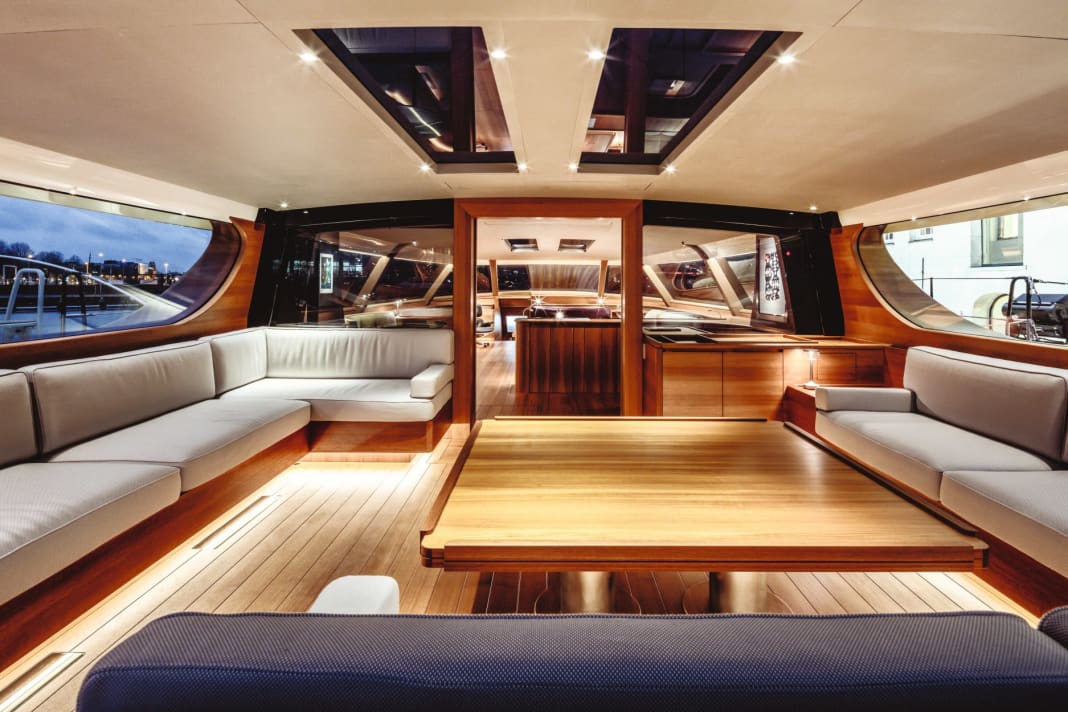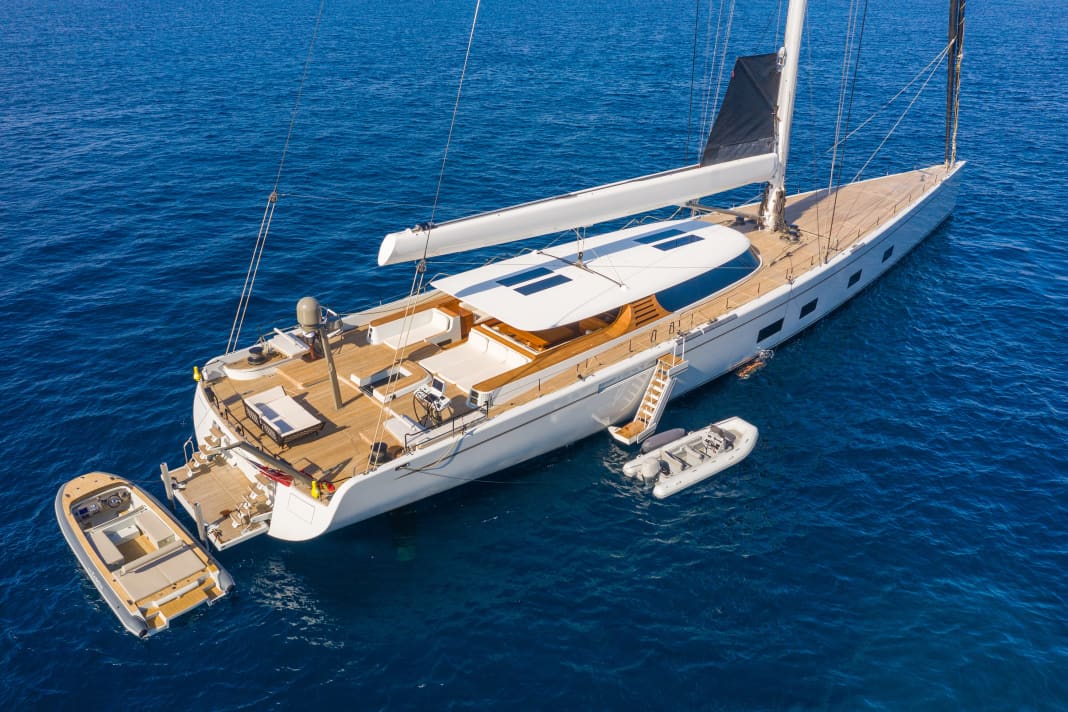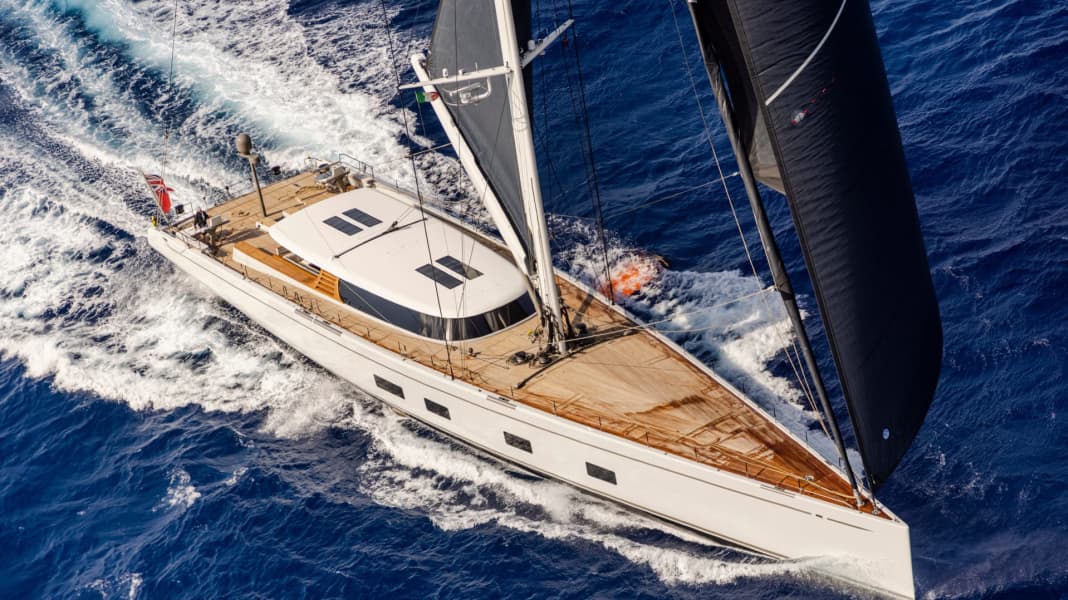
The most immediate confirmation of the creation of a timeless design comes from the confrontation with history. For example, the newly delivered "Canova" lies quite naturally in front of the Amsterdam Maritime Museum, a baroque building from the 17th century. The 43.30 metres appear neither alien nor ingratiating; even the size is blurred thanks to the proportions devised by Milan architect Lucio Micheletti and the moderate freeboard height - extremely clear forms in which a wealth of complex technologies are concealed.
To get an impression of its dimensions, just look into the open hatch behind the bow. Below, Mattia Belleri is standing next to two drums taller than a man. The Italian has been the captain of the "Canova" for many years and this time was also commissioned by the owner to take care of the project management. Like its predecessor, which is seven metres shorter and also named after the Italian neoclassical sculptor Antonio Canova, the owner once again had the boat built in the northern Finnish halls of Baltic Yachts. Made of carbon fibre, of course. Even the two-metre-high wheels next to Belleri are made of this lightweight fibre. Foresails are wrapped around their rims by touching the display, even the large bulbous ones. However, this is only possible because the triangular-shaped Code Zero has four corners and clews for better furling, reveals Belleri. The crew hoists the gennaker just behind the stem. The absence of a bowsprit once again emphasises the primary cruising design, albeit an extremely ambitious one. The 54 metre long carbon mast from Rondal was again positioned far aft and almost centrally above the keel by the Farr designers.
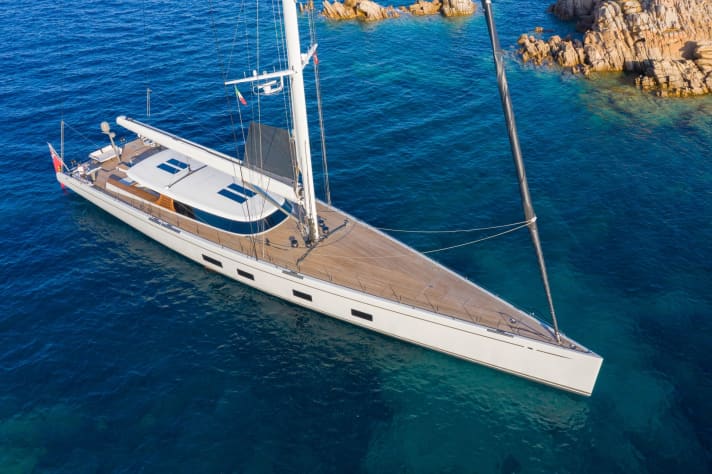
As with the offshore racers in the Imoca class, this results in many propulsion options: The storm jib, which is attached to the innermost staysail via riders, can be operated via the self-tacking sheets just like the staysail in front of it; Belleri furls the minimally overlapping genoa from 15 knots. The flat headsails are made of 3Di fibres from North Sails, like the furling boom main. The flared leech required a pair of backstays extending into the masthead, but the crew can use it like a fixed backstay from the first reef. Performance, safety and efficiency go hand in hand in the nine metre long bow area. The foresail drums rely on a hydraulic drive to enable stopping. However, the majority of the on-board systems are electrically operated, such as the bow thruster, which is located under a cover in front of our feet for easy maintenance. The two anchors are also transported deep into the hull using electricity. The steel chains, each 140 metres long and 16 millimetres thick, travel through tubes right up to just in front of the mast so that they do not negatively affect the trim under sail.
The unusual chain hike is representative of the "Canova" owner's speed sailing ambitions. "I bet that 99 per cent of yachts of this size only use gennakers or code zero during regattas and with 30 people on board," says Belleri, as we have the teak deck under our feet again and look towards the bow along the stay parade. The captain confirms: "The owner is an enthusiastic sailor and wants to use his entire sailing wardrobe. That's his right. I'm not going to say no just because the boss is cooking and there are only five of us." Surfing the world's oceans over-rigged and under-staffed only works thanks to an unconventional aid for a yacht of this size: the foil. Nine metres long and weighing 1.4 tonnes, the side wing brings together the superyacht maxim of comfort and safety with the promise of performance. Fully extended to a length of 6.40 metres to leeward, the lateral carbon centreboard generates a righting moment of 140 tonnes and reduces pitching by up to 40 percent and heeling angles by 34 percent, which corresponds to around twelve degrees. Baltic calculates that 33 tonnes of additional keel bomb mass would have been necessary to achieve 30 percent less lean angle without the foil. Fully parked, a stump protrudes from the whale's eye in the hull, which immediately releases any line dragging in the water.
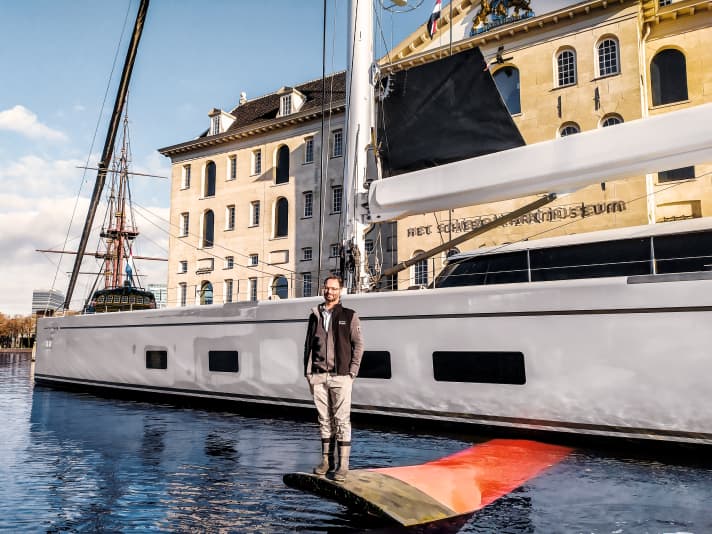
"We knew it would generate lift and reduce both heeling and drag, but we didn't expect a significant reduction in pitching," says DSS inventor Gordon Kay, describing his researcher's luck and the reason why the foil runs directly under the owner's cabin, even under the bed. Kay developed the Dynamic Stability System (DSS) together with Hugh Welbourn and had it patented over ten years ago. Under the Infiniti Yachts brand, the English company has so far brought regatta boats up to 14 metres long to the starting line, which, like "Canova", do not take off completely. Kay uses a formula to prove that the DSS is even more effective on larger yachts. This is because the dynamic buoyancy force increases in proportion to the square of the inflow velocity, which is highly dependent on the waterline length. The 30-metre-long "Wild Oats XI" proved this back in 2013 when it won the Sydney Hobart offshore classic with a DSS foil protruding two metres from the hull.
For the "Canova" owner, any increase in the hull speed of 16 knots is a bonus effect. Captain Belleri reported a 25-knot surf in the Bay of Biscay after the stop in Amsterdam. He attributes four to five knots increase to the foil. This is remarkable in that crews usually take it easy on crossings and rely on conservative sailing. A twin display, which rises from the aft coaming and can be easily recognised from the titanium steering wheels located far outboard, provides information about the boat's speed and heel angle. In addition, the running decks are wider than average and the stern extends behind the twin rudder system to the maximum hull width of nine metres.
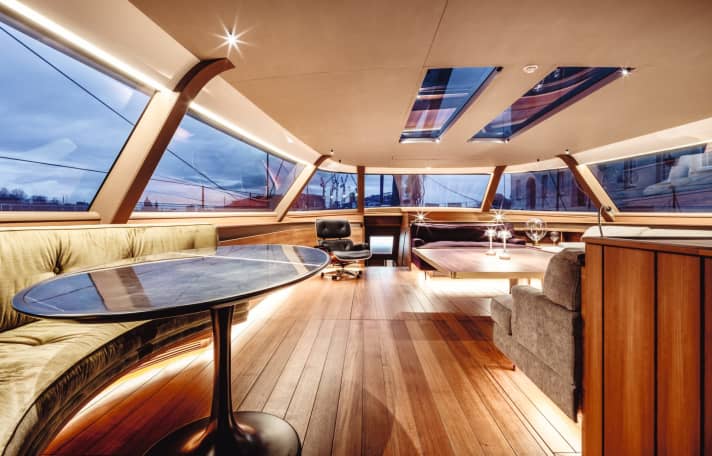
Baltic was not alone in integrating the foil into a superyacht that spends large parts of the year at sea. Alongside Infiniti Yachts, the Finns gathered a team of engineers and composite experts. Farr Yacht Design adapted calculations, as the wing protrudes from a structurally highly stressed hull section. To this end, the design office from the US East Coast, which specialises in racing yachts, was in constant contact with the Swiss composite manufacturer Gurit. The latter used FE analyses to determine the laminate structure of the exit stiffeners and the wing and its watertight cassette. BAR Technologies, the technicians of the British America's Cup challenger INEOS, produced 25 massive composite bearings. To save time, Baltic tested the fit and retraction mechanism with a dummy. The original laminated by Isotop in France, as Captain Belleri discovered during the first test strokes, can still be extended at speeds of up to 17 knots.
The 20 tonnes of pulling force of the captive carbon winch are transferred via lines and blocks to the rollers, which ultimately move the wing - a system that is all about safety and simplicity. Another important point for Gordon Kay: "We knew that 'Canova' would disappear after delivery and that we couldn't simply fly to Palma for repairs." And should the DSS foil break, which has not yet happened to Kay, there is still the 6.50 metre deep lift keel with fin and trim tabs made of polished duplex stainless steel. The foil only complements the gleaming APM keel. "With the keel fully raised, we could even sail with a draught of 3.80 metres, for example in the Bahamas or the Pacific," says project manager Mattia Belleri happily. Shortly afterwards, he is once again submerged and - like a captain - shows off the hidden details.
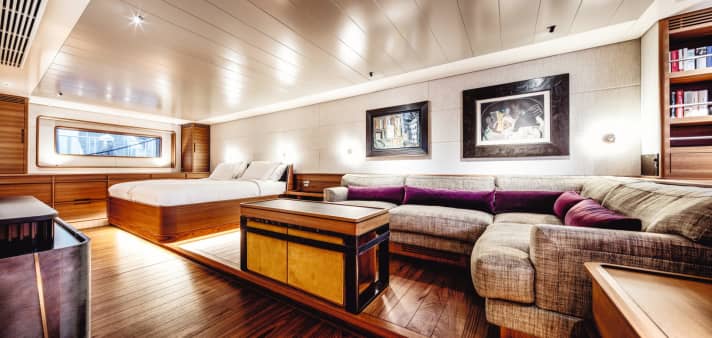
This time it is the control hatch for the wing box between the owner's bed and the coffee table, where two poufs are parked. If required, they can be moved into the almost eight square metre bathroom, which is adjoined by a sauna at the front. The highlight: only the concave teak seat surface needs to be removed in order to use the carbon bathtub underneath. In the interior, too, it is difficult to take your eyes off the omnipresent technical refinements. For example, a tilting mechanism has been implemented in the owner's bed, which eliminates the last bit of heeling during night-time passages. This is not a novelty in itself, but in combination with the foil running underneath it is a little more complicated. The built-in wardrobes are based on Nomex carbon frames, which are adorned with wafer-thin teak veneer. In the owner's cabin and the guest areas, the walls are "only" two metres high. The reason for this is a 1.10 metre high gap under the deck, which made it impossible to install skylights and complicated the ventilation. Among other things, the eight Kaptiv winches, which are accessible via a deck hatch and which Harken made from carbon fibre for the first time, work here. The owner rejected the usual aluminium version due to the additional weight of 200 kilograms.
The large hull windows, the brightly panelled ceilings and a still life by Georges Braque and an illustration of the column of San Marco, which Lucio Micheletti wrapped in blue for the Biennale, belie the cover. Past further art prints and the companionway, the owner reaches the reading and entertainment corner on the port side with a fixed TV, which becomes the third guest cabin thanks to the sofa bed, sliding wall and day toilet access. Opposite, to starboard, is the regular guest cabin with two single beds, and at the very front is a five-metre-wide VIP suite, which is reserved for the owner on formats of a comparable size. When sailing and coming from the cockpit, guests and owners use the day toilet in the aft crew area. The quality of the fittings and choice of materials is only inferior to the guest areas in front of the engine room in terms of the cork floor. Lucio Micheletti, "Canova's" interior and exterior designer, compares the crew lounge to a piazza. Spacious cabins for a maximum of six people lead off from the navigation alcove and galley in a star shape. Micheletti earned his design spurs in the automotive segment, where he specified the shapes of the Alfa Romeo and Fiat bodies for the legendary Zagato studio. For Nardi Italia, the Milanese designer moulded the interiors of various BMW and Aston Martin models. On the water, he was responsible for the interior design of the fast series cruisers from Solaris.
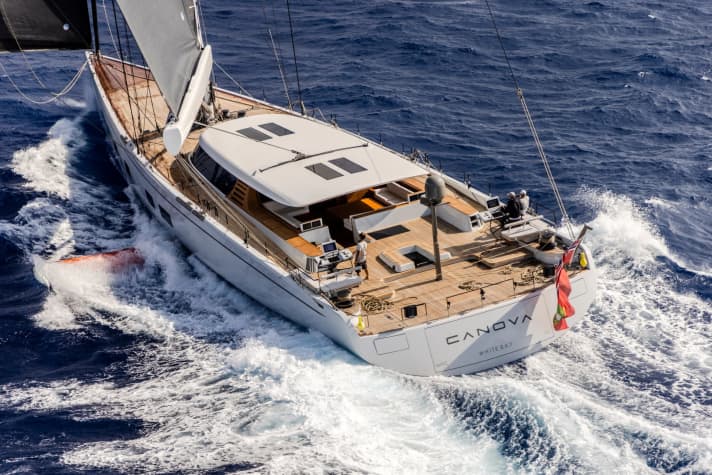
The owner approached Baltic with a preliminary layout that he had commissioned. Belleri explains: "We want to be globetrotters and travel with fewer guests than crew. A high degree of autonomy was very important to us." In addition to the standard equipment, the chef operates a glass freezer, vacuum sealer and a fast gastro dishwasher. The ironing corner on the starboard side opens up another sleeping option with its day bed. A laundry with two washing machines and a cold room are spread across the two helm stations. In between, steps made of exposed carbon fibre lead to the two steering consoles, directly and without a diversion around the mainsheet. The roof variant was chosen for reasons of guest safety. In order to withstand a mainsheet load of 24 tonnes, Baltic installed the traveller rail on a carbon bulkhead that extends from the underwater hull up to the edge of the superstructure. A no less demanding effort in composite required a hardtop bimini almost five metres long, which floats above the cockpit without any supports. Windows that can be raised to the side give the impression of a saloon extension, but the unmistakable difference between outside and inside is emphasised by a Chagall painting on the port side and a lounge chair by Eames just before the companionway. Micheletti points out that the leather reading area is held in position by four carbon fittings in rough seas, which he would have liked to have been larger and rounder, but which Baltic shaped into an oval to optimise weight.
Vision Systems from France supplied electrically dimmable windows and skylights for the eight-metre-long saloon. These guarantee strong UV protection for people, wood and art and prevent the helmsman from being dazzled in the dark. "It was important to us to keep the heat out as much as possible. After all, the air conditioning is the biggest energy consumer," explains Belleri. A B&G display and throttle lever for controlling the Danfoss Editron electric motor appear next to the Eames chair. The 420-kilowatt electric motor with switchable power transmission and 16 inverters is water-cooled and rotates in the engine room located amidships and directly above the controllable-pitch propeller, which can be turned through 340 degrees. Using recuperation, "Canova" already harvested an average of 25 kilowatts of green energy at 17 to 20 knots of gliding speed. Danfoss Editron supplied the complete electric drive system based on direct current distribution. This also includes the efficient control of the electric winches and the two customised diesel generators from Cummins, which Baltic packaged in soundproofed carbon boxes. In addition, the Danish-Finnish supplier of hybrid systems developed two DC/DC converters for the Akasol battery banks with a capacity of two times 180 kilowatt hours.
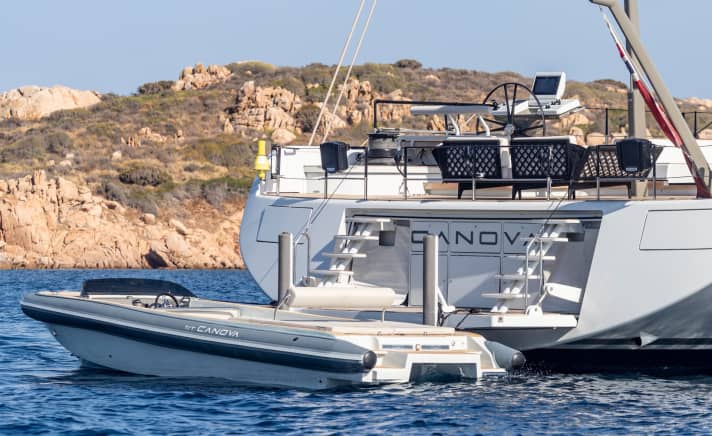
The seven metre long custom tender with a 1000 litre additional tank made of PVC extends the mothership's autonomy upwards. Due to the high draft of the forestay, the foredeck garage hatch is structurally part of the deck and closes hydraulically. In contrast, the davits are operated manually, including the one at the stern for the 4.60 metre long crew tender. The RIB rises vertically because the owner wanted to keep the transom small. The use of muscle power saves 1.6 tonnes of weight and, of course, energy compared to hydraulic cranes. Energy is even generated via the winches when the boat is being lowered, an idea that Belleri, who studied engineering, brought to Baltic. Originally, the captain and owner wanted to do without fossil fuels altogether, but solar panels on the roof would only have been just enough and would have caused classification problems. Wind turbines were also discussed, but would have been too disruptive on deck and would have required a 60 metre cable for the mast installation. "In ideal wind conditions, we can cross the Atlantic without the help of generators," says Belleri confidently, adding: "The owner lives on board and wants to sail around the world." In any case, "Canova" has registered for the Maxi Yacht Rolex Cup. At the beginning of September, there will certainly be more than six people on board off Porto Cervo, and perhaps the 30-knot mark will even be exceeded.
